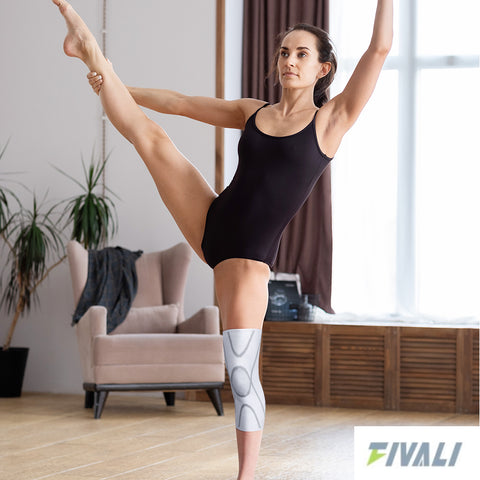4 Exercises to Strengthen Knee Muscles

Today, Fivalifitness will discuss some excellent workouts for recovering from knee pain. These four exercises are intended to develop not just the muscles surrounding your knee, but also to enhance symmetry between your left and right knees, as well as the front and back muscle groups.
It's critical to keep both knees healthy and balanced, especially if one knee or ankle has been injured. Uneven pressure on one knee can cause stress and strain on the other, thus these exercises can be quite beneficial in relieving that asymmetrical stress. Let's get started and work together to achieve healthier, happier knees!
Structure of the Knee Joint
To exercise safely and avoid injury, it's critical to understand the structure and function of the knee joint. The knee joint is the body's largest hinge joint, linking the femur (thigh bone) to the tibia (shin bone) via four ligaments that maintain the knee stable and prevent excessive motion.
The patella (kneecap) sits in front of the knee and slides over the tendon that connects the quadriceps muscle at the front of the thigh. During actions such as walking, running, and jumping, the patella protects the knee and increases the quadriceps muscle's leverage.
The quadriceps muscles at the front of the thigh, which extend the leg; the hamstrings at the back of the thigh, which flex the leg; and the calf muscles, which help support the ankle joint, are all attached to the knee joint.
The tiny fibula bone, which is located on the outside of the lower leg and aids in ankle joint stabilization, is in addition to the femur and tibia bones. Finally, there is articular cartilage, which covers the ends of the femur and tibia bones where they meet at the knee joint. This cartilage cushions the joint and reduces friction between the bones as it moves.
Quad Stretch
The first exercise we'll go over is the quad stretch. You'll begin by rising up and looking for a wall for support. Put one hand against the wall and the other on your foot or ankle, bringing it up towards your hamstring. This will stretch your hip flexors as well as your quadriceps.
Take note of any differences in flexibility between your left and right sides while you hold the stretch. It's very natural for one side to feel tighter than the other. Just concentrate on stretching the tighter side a little more.
Hold the stretch for 30 seconds on each side, then repeat. You'll progressively develop your flexibility and improve your general balance and coordination with persistent practice. So, let's stretch those quads and see what happens!
Calf Stretch
The following stretch will be the heel-to-calf stretch. In this case. You'll put your hands on the wall and take a step back. As a result, your toes are pointing forward. Make sure your heels are flat and your knees are slightly bent. Then, lean into the stretch and hold it for 30 seconds. When you're finished with it, move on to the opposite leg. So you'll execute this exercise back and forth merely two times. As opposed to the quad stretch, which extends the front of the leg, this exercise will stretch the back of your leg.
fivalifitness.com
Half Squat
The half squat is a fundamental leg strengthening exercise that targets the quadriceps, glutes, and hamstrings. To begin, stand with your feet shoulder-width apart and lower yourself into a partial squat position, pausing when your thighs are parallel to the ground.
This exercise stretches and strengthens the hip and knee extensor muscles, which are essential for walking, running, and other lower-body activities. Individuals can improve their general fitness, athletic performance, and risk of injury by progressively increasing strength and endurance through frequent repetition of the half squat.
Begin with 2-3 sets of 10 repetitions each. To avoid putting undue strain on the knees or lower back, maintain appropriate form throughout the exercise. Individuals can safely and efficiently implement the half squat into their training program to build better lower body strength and mobility with constant repetition and attention to technique.
Straight Leg Razor

Straight leg razor exercises are excellent for strengthening your quadriceps and hip flexors. Begin by lying down on a mat or carpet, one leg bent and the other straight out in front of you.
Next, raise your foot to feel your shin muscles contract. Contract the quadriceps muscle in your straight leg and steadily raise it off the floor until it is the same height as your bent knee, without using weights. Hold this position for about 5 seconds before lowering back to the mat, then repeat 10 times.
As you improve, you can add weight to your ankle by starting with a 5-pound weight and gradually increasing to higher weights such as 7 or 10 pounds.
Remember to take breaks between sets and don't overdo it. You can progressively develop your lower body strength and flexibility by including this workout into your program 2-3 times per week.
Taking care of our knees is critical for overall health and mobility. You may strengthen the muscles around your knee, increase symmetry between your left and right knee, and lower your risk of injury by including these five exercises into your program. You can also run while wearing a sports knee brace to strengthen your knees. It's also critical to be aware of any imbalances or pain in your knees and to employ strategies like the balancing technique we described to alleviate discomfort and keep your muscles in balance. You can acquire stronger, healthier knees and reap the benefits that come with them with constant practice and attention to form. So, let's get started on our path to happier knees right away!
fivalifitness.com
*Disclaimer
The information provided in articles written by Fivali is intended for educational and reference purposes only. The content on this website (www.fivalifitness.com) is not intended to diagnose, treat, cure, or prevent any disease. We do not recommend self-diagnosis or self-treatment based on the information provided in our articles. Always consult a qualified healthcare professional if you have any concerns about your health or well-being.
If you are experiencing any symptoms or discomfort, we strongly encourage you to seek medical attention from a qualified healthcare professional. Only a licensed healthcare practitioner can provide an accurate diagnosis and an appropriate treatment plan tailored to your individual needs.
0 comments


